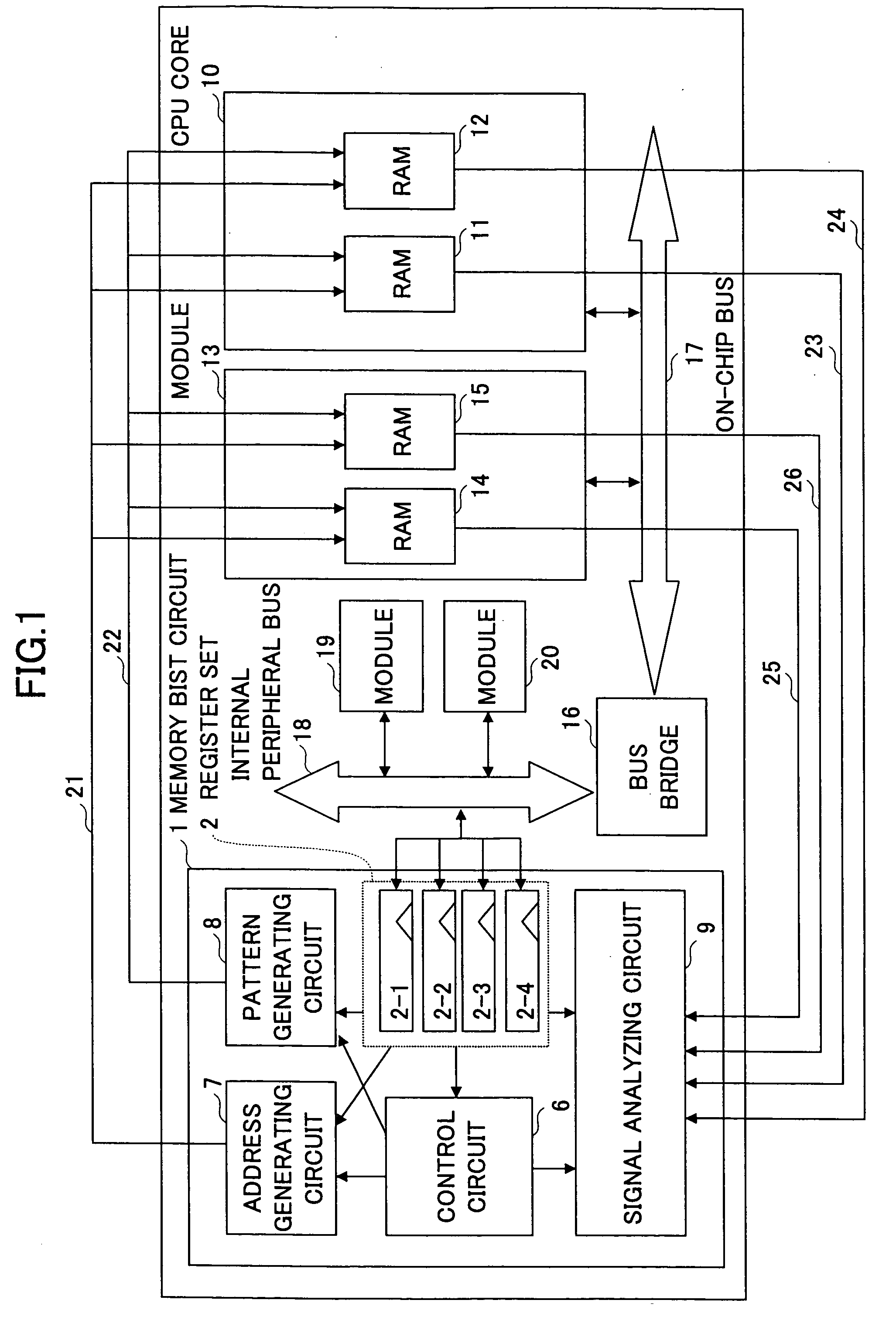Semiconductor device capable of performing test at actual operating frequency
a technology of a semiconductor device and a test frequency, which is applied in the direction of instruments, coding, code conversion, etc., can solve the problems of inability to detect a malfunction, long time required for testing memory operations, and inability to perform operation tests, so as to avoid performing operation tests, effective detection of delay-associated failures, and convenient conductance
- Summary
- Abstract
- Description
- Claims
- Application Information
AI Technical Summary
Benefits of technology
Problems solved by technology
Method used
Image
Examples
first embodiment
[0033]FIG. 1 is a block diagram showing the construction of a semiconductor device in which a memory BIST circuit is incorporated according to the invention. The semiconductor device of FIG. 1 is a processor that operates at high operating frequency by use of a clock signal output from a PLL, for example, and includes a memory BIST circuit 1, a CPU core 10, a module 13, a bus bridge 16, an on-chip bus 17, an internal peripheral bus 18, a module 19, a module 20, a control signal line 21, a write-data signal line 22, and read-data signal lines 23 through 26. The CPU core 10 includes an instruction cache RAM 11 and a data cache RAM 12. The module 13 includes an in-module RAM 14 and an in-module RAM 15. The memory BIST circuit 1 is provided for the purpose of testing the operations of the instruction cache RAM 11, the data cache RAM 12, the in-module RAM 14, and the in-module RAM 15. For the sake of explanation, a PLL circuit and other circuitries irrelevant to the operation of the memo...
second embodiment
[0052] In the following, the semiconductor device according to the invention will be described.
[0053] When a memory BIST circuit is implemented as a wrapper circuit around a memory as in a conventional configuration, at least one stage of a selector needs to be inserted into a path for memory input / output. If such a selector is inserted into a path leading to a cash RAM of the CPU, it may worsen the timing of a critical path when such a critical path is already critical as to its timing. On the other hand, the provision of signal lines dedicated for use in the memory BIST test results in an undesirable increase in the number of signal lines. In the second embodiment described below, a selector is provided at a location where timing is not critical along a data bus, and the switching of polarities of a test signal allows the memory BIST circuit to access a memory in a pipeline manner.
[0054]FIG. 5 is a block diagram showing an example of the second embodiment of the semiconductor dev...
third embodiment
[0060] In the following, the semiconductor device according to the invention will be described.
[0061] When the operating frequency of a semiconductor device increases from hundreds Mega-hertz to the order of Giga-hertz, the transfer of data between the memory BIST circuit 1 and memories requires an increased time length. As such time length is increased relative to the clock cycle, it becomes difficult to ensure proper operations timing-wise. Especially with the provision of the memory BIST circuit 1 consolidated in a single location, a distance from this location to each memory causes such timing issues to come to the surface. In consideration of this, the third embodiment provides buffer registers (pipeline registers) along a path through which data is supplied from the memory BIST circuit 1 to a memory and along a path through which data is read from the memory to the memory BIST circuit 1, thereby achieving pipeline operations.
[0062]FIG. 6 is a block diagram showing an example ...
PUM
 Login to View More
Login to View More Abstract
Description
Claims
Application Information
 Login to View More
Login to View More - R&D
- Intellectual Property
- Life Sciences
- Materials
- Tech Scout
- Unparalleled Data Quality
- Higher Quality Content
- 60% Fewer Hallucinations
Browse by: Latest US Patents, China's latest patents, Technical Efficacy Thesaurus, Application Domain, Technology Topic, Popular Technical Reports.
© 2025 PatSnap. All rights reserved.Legal|Privacy policy|Modern Slavery Act Transparency Statement|Sitemap|About US| Contact US: help@patsnap.com



